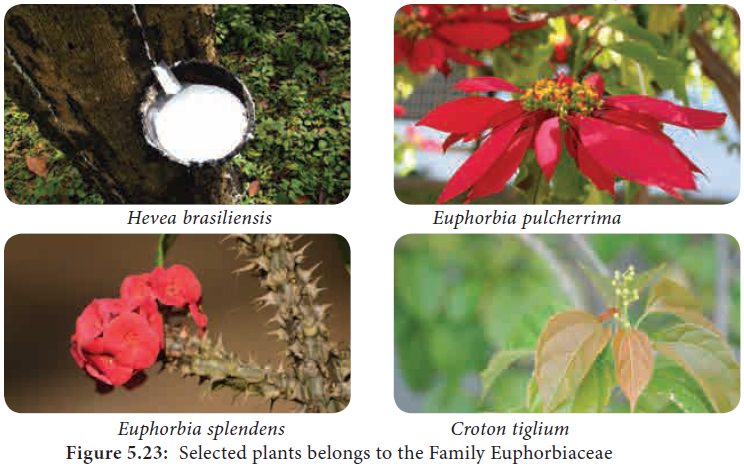Systematic position, Diagnostic and General characters, Botanical description, Floral Formula, Economic Importance - Family: Euphorbiaceae (Castor Family / Spurge Family) | 11th Botany : Chapter 5 : Taxonomy and Systematic Botany
Chapter: 11th Botany : Chapter 5 : Taxonomy and Systematic Botany
Family: Euphorbiaceae (Castor Family / Spurge Family)
Family: Euphorbiaceae (Castor Family / Spurge Family)
(In APG classification Peraceae, Phyllanthaceae and Picrodendraceae are excluded from the family Euphorbiaceae)
Systematic position
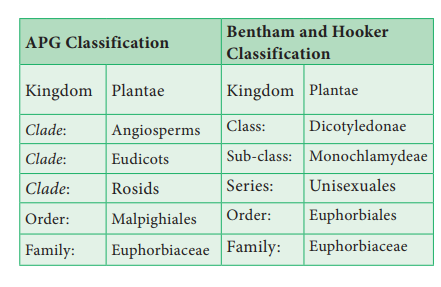
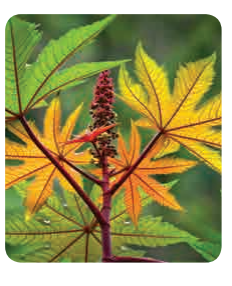
Diagnostic features
· Latex is present either milky or watery.
· Inflorescence generally cymose, catkin in Acalypha, cyathium in Euphorbia sp.
· Flowers apetalous, unisexual.
· Ovary tricarpellary, distinctly trilobed.
· Fruit capsule or regma.
General characters
Distribution: Euphorbiaceae includes 214 genera and about 5600 species. The plants of this family are found throughout the world. Well represented in Africa and South America.
Habit: Mostly shrubs (Ricinus communics, Jatropha gossypifolia) or tree Emblica officinalis, herbs (Phyllanthus amarus) , twiners (Tragia involucrata) some are xerophytic (Euphorbia) with cactus – like (phylloclades) plants usually contain milky or watery sap.
Root: Well branched tap root system.
Stem: Aerial, erect or prostrate (E.prostrata), herbaceous or woody. Stem becomes modified into flattened, leaf-like and becomes succulent in several species of Euphorbia. Such modified stem is called phylloclades. Cylindrical, branched, solid or hollow, usually contain latex either milky (E.tirucalli) or watery (Jatropha curcas).
Leaf: Stipulate or exstipulate. Mostly simple, alternate, often reduced or deciduous as in several species of Euphorbia, palmately lobed in Ricinus or deeply lobed in Manihot. The stiplues are modified into a pair of spines (E.splendens) or glandular hairs (Jatropha curcas ). The leaves around the cyathium inflorescence become beautifully coloured in E.pulcherrima (Paalperukki tree) with unicostate or multicostate reticulate venation.
Inflorescence: The inflorescence of Euphorbiaceae varies greatly, Terminal raceme – Croton, Ricinus, Catkin – Acalypha hispida Cyme - Jatropha, solitary axillary – Phyllanthus asperulatus, cyathium – Euphobia species.
Cyathium is the an unique and special inflorescence of this family. Each cyathium contains centrally a single, naked terminal female flower, usually represented by a tricarpellary gynoecium. The female flower is surrounded by a cup-like involucre formed by 4 or 5 connate sepaloid bracts. In the axil of each bract develops a group of stamens in a scorpioid manner. Each stamen represents a naked male flower because it is a jointed structure, its upper portion is the filament bearing the anther and its lower portion represents the pedicel of the male flower bearing stamen. A nectar secreting gland is present on the rim of the involucre. Glands are oval or crescent shaped and often brightly coloured. Though cyathium appears like a single flower, it actually an inflorescence.
Flowers: Flowers are always unisexual, and are highly variable. Bracteate, ebracteolate, generally unisexual, homochlamydeous, rarely heterochlamydeous, monoecious (Baliospermum) or dioecious (Bridelia), actinomorphic, rarely zygomorphic, hypogynous, rearly perigynous (Bridelia).
Perianth: Tepals 0 to 5 biseriate (male flowers of Croton bonplandianum) uniseriate or aphyllous (Euphorbia), valvate or imbricate when present, apophyllous or synphyllous.
Androecium: The number of stamens vary from 1 to many. In Euphorbia a single stalked stamen represents a single male flower. In Ricinus usually 5 stamens are present, but each stamen is profusely branched. In Jatroph a they are arranged in two whorls each of 5 stamens. The stamens are indefinite (Crotons), the filaments may be free or connate. The anthers are dithecous, dehisce either by apical or by transverse or longitudinal slits.
![]()
![]()
![]()
Gynoecium: Tricarpellary, rarely bicarpellary (Bridelia, Mercurialis), tetra or pentacarpellary
(Wielandia), syncarpous, ovary superior, rarely semi-inferior, ovules one or two in each locule on axile placentation, rarely locule splits into two forming six chambers (Phyllanthus ). Styles 3, each split into two feathery stigma. Nectaries are usually present, gynoecium is present as a pistillode in staminate flowers.
Fruit:Fruits are capsule orschizocarp. It breaks violently and dehisce into three one seeded cocci called regma (Ricinus ), drupe in Emblica officinalis and berry or samara.
Seed: Seeds are endospermous. In Ricinus knob-like caruncle develops from the micorpyle,that absorbs and temporarily retains water enabling germination.
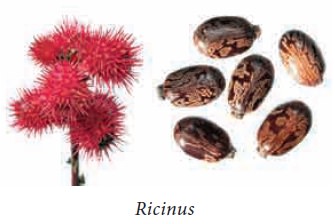
Botanical Description Of Ricinus communis (Castor)
Habit: Tall perennial shrub
Root: Branched tap root system
Stem: Aerial, erect, cylindrical, branched and hollow, solid at the base, glabrous,
Leaf: Simple, petiolate, hollow, exstipulate, alternate, broad, palmately lobed, usually 7-9 lobes, serrate, palmately reticulate divergent venation.
Inflorescence: Terminal panicle.
Male Flower Bracteate, ebracteolate, pedicellate, male flowers (open for one day) towards lower portion of the inflorescence, actinomorphic, incomplete.
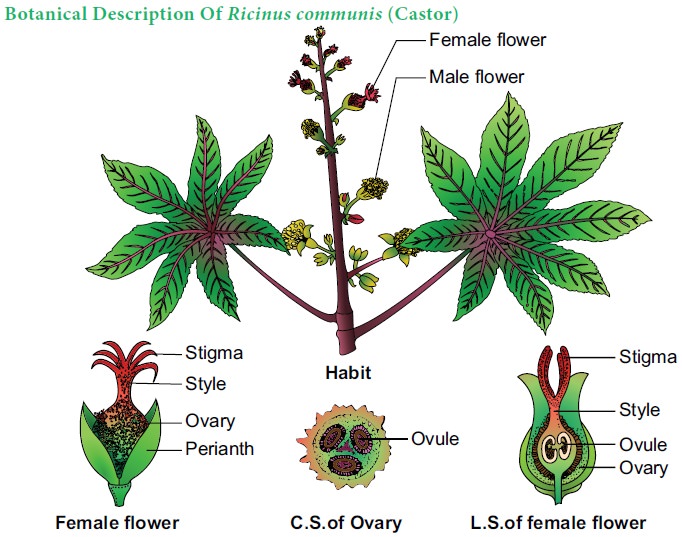

Perianth: Tepals 5, apophyllous, uniseriate, green, valvate aestivation, odd tepal posterior in position.
Androecium: Stamens numerous (upto 1000) crowded and connate into about 8mm long cluster of stipitate phalanges, each stamen profusely branded, anthers globose basifixed.
Gynocium: usually absent rarely represented by pistillode.
Female Flower Bracteate, ebracteolate, pedicellate, female flowers (open for fourteen days) found towards the apical portion of inflorescence, actinomorphic, incomplete and hypogynous.
Perianth: Tepals 3, apophyllous, green valvate.
Androecium: Absent but staminode is present.
Gynoecium: Tricarpellary, syncarpous, ovary superior, distinctly trilobed, trilocular, covered with spiny outgrowth, single large ovule in each locule on axile placentation, style three with three bifid stigma.
Fruit: A schizocarp with spiny outgrowth, splits into three one seeded cocci.
Seed: Endospermous, knob-like caruncle develops from the micorpyle, that absorbs and temporarily retains water enabling germination.
Floral Formula:

Economic importance of the family Euphorbiaceae

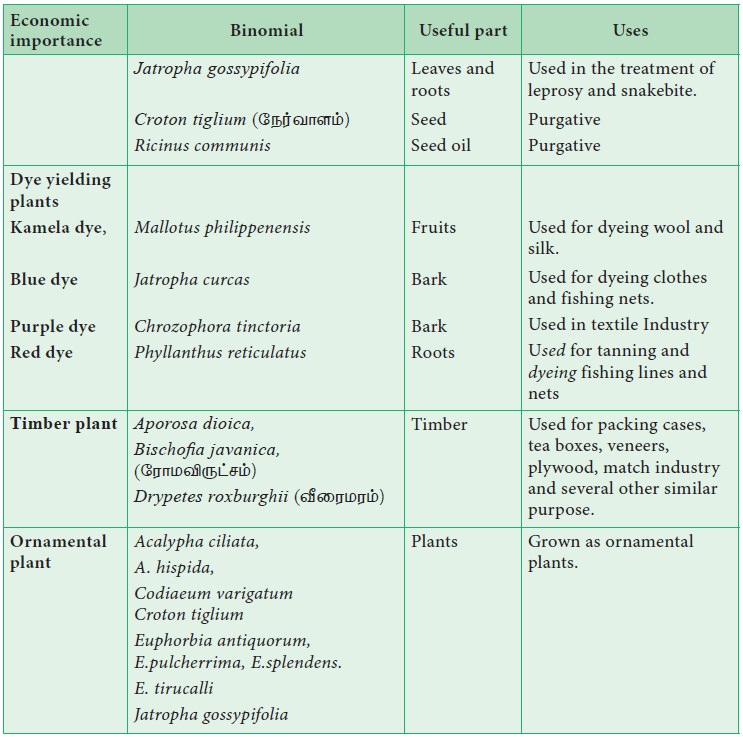
Related Topics
